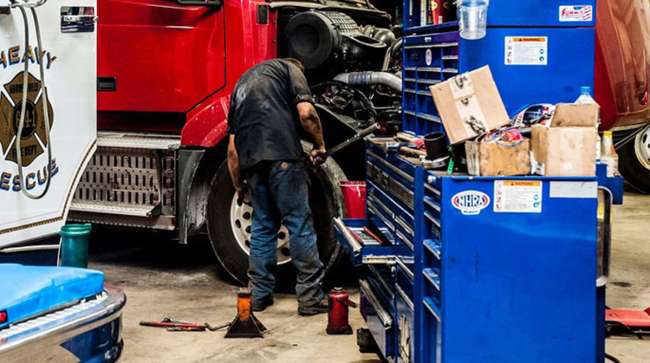Staff Reporter
Heavy-Duty Repair Shops Report Drop in Revenue Due to Pandemic

[Ensure you have all the info you need in these unprecedented times. Subscribe now.]
A majority of heavy-duty repair shops saw a significant drop in revenue due to the coronavirus pandemic in 2020, a new report found.
According to the “State of Heavy-Duty Repair” study, released Feb. 17, about 54% of survey participants reported a decline in revenue last year. Revenue remained about the same for 28% of respondents, and increased for 15% of them.
The study, conducted by truck repair software provider Fullbay and the Technology & Maintenance Council of American Trucking Associations, found that on a monthly basis overall average declines peaked during May at 22%, then steadily narrowed from there and rebounded by December to a 7% upswing compared with year-ago levels.
The volatile conditions created by the pandemic were cited as the key reason for the declines most saw, as truck repair shops under normal conditions routinely have plenty of work, said Jacob Findlay, the co-founder and CEO of Fullbay.

Findlay (Fullbay)
“We’re pretty confident that this is COVID causing this decrease,” Findlay told Transport Topics. “The biggest concern for shops is not finding business, it’s finding technicians. In 2020 business fell off a cliff for a few months.”
“The obstacles faced by heavy-duty repair shops aren’t new, but it is obvious that the pandemic presented a whole new set of hurdles for our industry,” TMC Executive Director Robert Braswell said in a Feb. 17 statement.
The report included input from 340 users and nonusers of Fullbay services, as well as shop management data from a sample of 250 repair shops that used the company’s platform for a full year. The average annual gross revenue per shop of those surveyed was between $500,000 and $2 million.
Findlay said the survey was initially launched in collaboration with TMC to provide repair shops with information that could help them measure themselves against others in the industry, something he said customers had been asking for. Data collection for the survey was already underway when the pandemic struck, he said.
“We felt like there wasn’t anything like this out there to benefit the shops — for them to put themselves in context in the industry, and see where they stood,” Findlay said. “Then COVID hit. And so it put us in this unique position.”
Findlay said that there were indications shops were closing down at an unusually higher rate toward the end of a tumultuous 2020. “I think there were shops that maybe weren’t capitalized enough to withstand the downturn, and they just couldn’t stay open, and so there may be echoes of that into 2021.”

Fleets are investing in tech-based safety tools that inform and forewarn potential risk. But how do they condition and prepare drivers to respond to safety alerts? Find out as the RoadSigns Team speaks with Tom DiSalvi, VP of safety at Schneider National, and Charlie Mohn, director of product innovation at Drivewyze. Hear a snippet, above, and get the full program by going to RoadSigns.TTNews.com.
He also noted that heavy-duty shops on average saw revenue increase 6%-12% between 2018-2019.
Looking ahead, he said shops are optimistic that 2021 will return the sector to strength.
“We’ve done small sentiment polls — kind of like a consumer sentiment poll, but shop sentiment — asking for their expectations on 2021 revenue, and they’re overwhelmingly positive,” he said. “I think it’s over 90% believe they will have higher revenue in 2021 than they saw in 2020.”
But, he noted, the service sector still has ground to cover in the year ahead.
“We’ll have to see where the numbers actually shake out,” Findlay said. “It’s too early to know, obviously.”
Want more news? Listen to today's daily briefing below or go here for more info:



